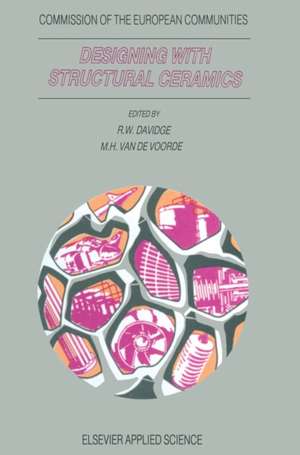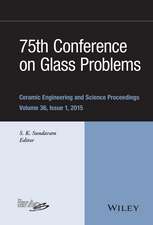Designing with Structural Ceramics
Editat de R.W. Davidge, M.H. Van de Voordeen Limba Engleză Hardback – 31 dec 1991
Preț: 402.98 lei
Nou
Puncte Express: 604
Preț estimativ în valută:
77.12€ • 83.74$ • 64.78£
77.12€ • 83.74$ • 64.78£
Carte tipărită la comandă
Livrare economică 22 aprilie-06 mai
Preluare comenzi: 021 569.72.76
Specificații
ISBN-13: 9781851667406
ISBN-10: 1851667407
Pagini: 351
Ilustrații: VIII, 343 p.
Dimensiuni: 170 x 244 mm
Greutate: 0.77 kg
Ediția:1991
Editura: SPRINGER NETHERLANDS
Colecția Springer
Locul publicării:Dordrecht, Netherlands
ISBN-10: 1851667407
Pagini: 351
Ilustrații: VIII, 343 p.
Dimensiuni: 170 x 244 mm
Greutate: 0.77 kg
Ediția:1991
Editura: SPRINGER NETHERLANDS
Colecția Springer
Locul publicării:Dordrecht, Netherlands
Public țintă
ResearchCuprins
Perspectives of Structural Ceramics and Present R&D Efforts.- Engineering Properties.- Mechanical Properties of Ceramics.- Fracture Mechanics of Ceramics.- Weakest-Link Failure Prediction for Ceramics.- Creep of Non-oxide Ceramics Considering Oxidative Influences.- Practical Designing Aspects of Engineering Ceramics.- Ceramic Matrix Composites.- Characteristics of Ceramic Composites.- Whisker-Reinforced Composites.- Ceramic Matrix Composites: High Performance Damage Tolerant Materials.- Technological Aspects.- Machining Advanced Ceramics: A Challenge in Production Technology.- Joining of Ceramics.- Nondestructive Testing of Ceramic Engineering Components by X-ray, Ultrasonic and Other Techniques.- The Processing of Structural Ceramics.- Industrial Applications.- Ceramic Composite Development.- Ceramics in Aero-Engines.- Ceramics in the Automobile Industry.- Ceramics in Energy Generation Systems.- Applications and Design of Porous Ceramic Structures.- Current Research Activities.- Aligned Whisker Reinforcement by Gelled Extrusion.- Intermediate Temperature Bend Strength of 5wt% Yttria Stabilized Zirconia.- Ceramic Composite Materials: A Contribution to an Overall Technology Assessment.- Index of Contributors.




